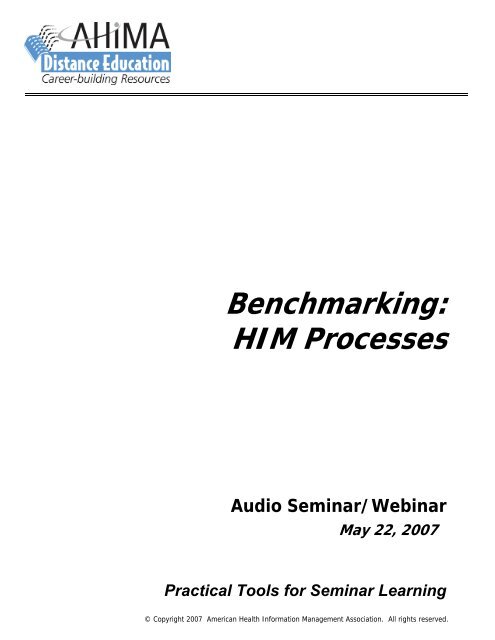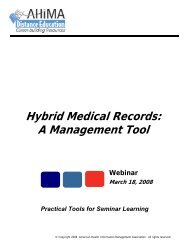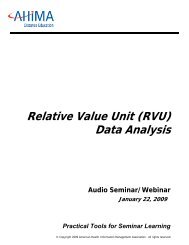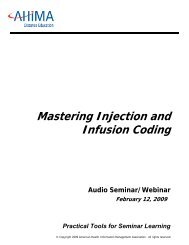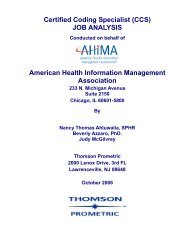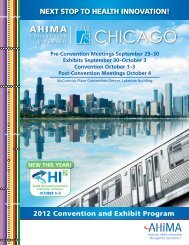HIM Processes - Log in - American Health Information Management ...
HIM Processes - Log in - American Health Information Management ...
HIM Processes - Log in - American Health Information Management ...
You also want an ePaper? Increase the reach of your titles
YUMPU automatically turns print PDFs into web optimized ePapers that Google loves.
Benchmark<strong>in</strong>g:<br />
<strong>HIM</strong> <strong>Processes</strong><br />
Audio Sem<strong>in</strong>ar/Web<strong>in</strong>ar<br />
May 22, 2007<br />
Practical Tools for Sem<strong>in</strong>ar Learn<strong>in</strong>g<br />
© Copyright 2007 <strong>American</strong> <strong>Health</strong> <strong>Information</strong> <strong>Management</strong> Association. All rights reserved.
Disclaimer<br />
The <strong>American</strong> <strong>Health</strong> <strong>Information</strong> <strong>Management</strong> Association makes no<br />
representation or guarantee with respect to the contents here<strong>in</strong> and<br />
specifically disclaims any implied guarantee of suitability for any specific<br />
purpose. A<strong>HIM</strong>A has no liability or responsibility to any person or entity<br />
with respect to any loss or damage caused by the use of this audio<br />
sem<strong>in</strong>ar, <strong>in</strong>clud<strong>in</strong>g but not limited to any loss of revenue, <strong>in</strong>terruption of<br />
service, loss of bus<strong>in</strong>ess, or <strong>in</strong>direct damages result<strong>in</strong>g from the use of this<br />
program. A<strong>HIM</strong>A makes no guarantee that the use of this program will<br />
prevent differences of op<strong>in</strong>ion or disputes with Medicare or other third<br />
party payers as to the amount that will be paid to providers of service.<br />
As a provider of cont<strong>in</strong>u<strong>in</strong>g education the <strong>American</strong> <strong>Health</strong> <strong>Information</strong><br />
<strong>Management</strong> Association (A<strong>HIM</strong>A) must assure balance, <strong>in</strong>dependence,<br />
objectivity and scientific rigor <strong>in</strong> all of its endeavors. A<strong>HIM</strong>A is solely<br />
responsible for control of program objectives and content and the selection<br />
of presenters. All speakers and plann<strong>in</strong>g committee members are expected<br />
to disclose to the audience: (1) any significant f<strong>in</strong>ancial <strong>in</strong>terest or other<br />
relationships with the manufacturer(s) or provider(s) of any commercial<br />
product(s) or services(s) discussed <strong>in</strong> an educational presentation; (2) any<br />
significant f<strong>in</strong>ancial <strong>in</strong>terest or other relationship with any companies<br />
provid<strong>in</strong>g commercial support for the activity; and (3) if the presentation<br />
will <strong>in</strong>clude discussion of <strong>in</strong>vestigational or unlabeled uses of a product.<br />
The <strong>in</strong>tent of this requirement is not to prevent a speaker with commercial<br />
affiliations from present<strong>in</strong>g, but rather to provide the participants with<br />
<strong>in</strong>formation from which they may make their own judgments.<br />
Some of the <strong>in</strong>formation <strong>in</strong> this presentation has been presented by Ms.<br />
Dunn at National A<strong>HIM</strong>A Conferences, State CSA Meet<strong>in</strong>gs, and HCPro and<br />
A<strong>HIM</strong>A Audio Sem<strong>in</strong>ars or published <strong>in</strong> various journals, newsletters, or<br />
books<br />
A<strong>HIM</strong>A 2007 Audio Sem<strong>in</strong>ar Series<br />
i
Faculty<br />
Rose T. Dunn, RHIA, CPA, CHPS, FACHE<br />
Ms. Dunn is a Past A<strong>HIM</strong>A President and recipient of A<strong>HIM</strong>A’s 1997 Dist<strong>in</strong>guished<br />
Member Award. She is Chief Operat<strong>in</strong>g Officer of St. Louis-based, First Class<br />
Solutions, Inc., a national health <strong>in</strong>formation management consult<strong>in</strong>g firm<br />
provid<strong>in</strong>g cod<strong>in</strong>g compliance and operational consult<strong>in</strong>g services.<br />
Rose started her career as Director of Medical Records at Barnes Hospital, a<br />
1,200-bed teach<strong>in</strong>g hospital <strong>in</strong> St. Louis. She was promoted to Vice President at<br />
Barnes and was responsible for more than 1,600 employees and new bus<strong>in</strong>ess<br />
development. After Barnes, she jo<strong>in</strong>ed MetLife where she worked with managed<br />
care organizations nationwide on a variety of operational, medical management,<br />
and network development issues. Rose also has served as a Chief F<strong>in</strong>ancial<br />
Officer of a dual hospital system <strong>in</strong> Ill<strong>in</strong>ois.<br />
Ms. Dunn is active <strong>in</strong> several professional associations <strong>in</strong>clud<strong>in</strong>g <strong>American</strong> Institute<br />
of Certified Public Accountants, <strong>American</strong> College of <strong>Health</strong>care Executives,<br />
<strong>Health</strong>care F<strong>in</strong>ancial <strong>Management</strong> Association, and <strong>American</strong> <strong>Health</strong> <strong>Information</strong><br />
<strong>Management</strong> Association. She holds fellowship status <strong>in</strong> HFMA, ACHE and A<strong>HIM</strong>A.<br />
She also is certified <strong>in</strong> healthcare privacy and security.<br />
She is the author of several texts <strong>in</strong>clud<strong>in</strong>g F<strong>in</strong>ance Pr<strong>in</strong>ciples for the <strong>Health</strong><br />
<strong>Information</strong> Manager, More with Less and Haimann’s <strong>Health</strong>care<br />
<strong>Management</strong>. In addition, she has published more than 200 articles and has<br />
made numerous presentations across the United States on a wide variety of<br />
topics.<br />
Cheryl Doudican, RHIA<br />
Rose@FirstClassSolutions.com<br />
(800) 274-1214<br />
Ms. Doudican is the Director of <strong>Health</strong> <strong>Information</strong> <strong>Management</strong> at Mercy <strong>Health</strong><br />
Center <strong>in</strong> Oklahoma City, Oklahoma. She currently serves as one of the <strong>HIM</strong> subject<br />
matter experts for the Sisters of Mercy <strong>Health</strong> System, which is currently <strong>in</strong> the<br />
process of migrat<strong>in</strong>g to a common <strong>in</strong>formation system platform. Cheryl has vast<br />
experience <strong>in</strong> the <strong>Health</strong> <strong>Information</strong> <strong>Management</strong> field, to <strong>in</strong>clude various leadership<br />
and consult<strong>in</strong>g positions. Cheryl has successfully modified workflows, decreased AR<br />
days, and successfully collaborated with departments such as Patient Accounts and<br />
Medical Staff <strong>in</strong> efforts to improve the revenue cycle process. Cheryl has successfully<br />
elim<strong>in</strong>ated all transcription outsourc<strong>in</strong>g for her facility by conduct<strong>in</strong>g an operational<br />
review of transcription, evaluat<strong>in</strong>g payment methodologies and implement<strong>in</strong>g speech<br />
recognition.<br />
A<strong>HIM</strong>A 2007 Audio Sem<strong>in</strong>ar Series<br />
ii
Table of Contents<br />
Disclaimer ..................................................................................................................... i<br />
Faculty .........................................................................................................................ii<br />
Objectives ................................................................................................................... 1<br />
Issues Impact<strong>in</strong>g Productivity.......................................................................................... 2<br />
Poll<strong>in</strong>g Question #1............................................................................................... 3<br />
Productivity Standards.................................................................................................... 4<br />
Collect<strong>in</strong>g Data...................................................................................................... 4<br />
Poll<strong>in</strong>g Question #2............................................................................................... 5<br />
Establish<strong>in</strong>g Standards<br />
Actual Data—Inpatient Analysis .............................................................................. 6<br />
Address Variations................................................................................................. 7<br />
How Many Employees Do You Need........................................................................ 7<br />
Items to Consider.................................................................................................. 8<br />
Poll<strong>in</strong>g Question #3..............................................................................................10<br />
Design<strong>in</strong>g the Incentive Plan ..........................................................................................10<br />
Unit Pay Plan .......................................................................................................11<br />
Monitor Quality and Productivity ............................................................................12<br />
Expectations and the Plan.....................................................................................12<br />
Transcription Case Study<br />
Poll<strong>in</strong>g Question #4..............................................................................................13<br />
A snapshot of transcription ...................................................................................14<br />
Purchased New Dictation and Transcription System.................................................14<br />
Evaluated Pay Methodologies ................................................................................15<br />
Speech Editors.....................................................................................................15<br />
A different approach to edit<strong>in</strong>g ..............................................................................16<br />
Production Ga<strong>in</strong>s from Speech Edit<strong>in</strong>g....................................................................16<br />
Poll<strong>in</strong>g Question #5..............................................................................................17<br />
What’s happened s<strong>in</strong>ce implement<strong>in</strong>g speech recognition.......................................17<br />
Clos<strong>in</strong>g Notes................................................................................................................18<br />
Appendices—FTE Analysis Form .....................................................................................19<br />
References and Resources .............................................................................................21<br />
Audience Questions<br />
Appendix .............................................................................................................31-32<br />
A – Time Ladder Analyst<br />
B – Time Ladder<br />
C – Guidel<strong>in</strong>es for Transcription Service All Functions<br />
D – Speech Edit<strong>in</strong>g Agreement (New Employee)<br />
E – Speech Edit<strong>in</strong>g Agreement<br />
F – Speech Performance Analysis<br />
CE Certificate Instructions<br />
A<strong>HIM</strong>A 2007 Audio Sem<strong>in</strong>ar Series
Benchmark<strong>in</strong>g: <strong>HIM</strong> <strong>Processes</strong><br />
Notes/Comments/Questions<br />
Objectives<br />
• Review factors that affect productivity<br />
• Discuss how to develop and monitor<br />
productivity standards for common <strong>HIM</strong><br />
functions<br />
• Apply productivity standard sett<strong>in</strong>g for<br />
hybrid environments<br />
• Reveal how one organization improved<br />
transcription productivity through the use<br />
of speech recognition<br />
• Discuss <strong>in</strong>centive plans considerations <strong>in</strong> a<br />
speech recognition environment<br />
1<br />
Golden Rule<br />
• Don’t assume that what is done<br />
at other places is the same as<br />
what is done at your place<br />
• Idiosyncrasies<br />
• System differences<br />
• Expectation differences<br />
2<br />
A<strong>HIM</strong>A 2007 Audio Sem<strong>in</strong>ar Series 1
Benchmark<strong>in</strong>g: <strong>HIM</strong> <strong>Processes</strong><br />
Notes/Comments/Questions<br />
Issues Impact<strong>in</strong>g Productivity<br />
• Environment<br />
(workplace/space/noise/hormones)<br />
• Technology (PC, access to on-l<strong>in</strong>e<br />
documents and other reports, pr<strong>in</strong>ters)<br />
• Ease of connection<br />
• Skills<br />
• Education and<br />
Experience<br />
3<br />
Factors Affect<strong>in</strong>g Productivity<br />
• Diversity makes jobs more reward<strong>in</strong>g<br />
• Specialization/Division of Labor improves<br />
productivity<br />
• Discussed by Adam Smith <strong>in</strong> his economics<br />
book An Inquiry <strong>in</strong>to the Nature and<br />
Causes of the Wealth of Nations (1776)<br />
• 10 p<strong>in</strong> makers-do<strong>in</strong>g all 18 tasks to make a<br />
p<strong>in</strong> ≅200 p<strong>in</strong>s per day<br />
• 10 p<strong>in</strong> makers-each do<strong>in</strong>g specialized<br />
tasks to make a p<strong>in</strong> (assembly l<strong>in</strong>e)<br />
≅48,000 p<strong>in</strong>s per day<br />
[Adam Smith]<br />
4<br />
A<strong>HIM</strong>A 2007 Audio Sem<strong>in</strong>ar Series 2
Benchmark<strong>in</strong>g: <strong>HIM</strong> <strong>Processes</strong><br />
Notes/Comments/Questions<br />
Factors Affect<strong>in</strong>g<br />
Productivity<br />
• Generations<br />
• Boomers: 1943-1961 “live to work”<br />
• Generation X: 1962-1981 “no burn out here”<br />
• Millenials/Gen Y: 1982-2002 “work to live”<br />
• Generational Behavior molded by:<br />
• Media<br />
• Pop Culture<br />
• Technology<br />
• Current Events<br />
• Economy<br />
• Diversity<br />
[Generations] 5<br />
Poll<strong>in</strong>g Question #1<br />
Are you experienc<strong>in</strong>g generational<br />
conflict <strong>in</strong> your workplace<br />
*1 Yes<br />
*2 No<br />
*3 Not sure<br />
6<br />
A<strong>HIM</strong>A 2007 Audio Sem<strong>in</strong>ar Series 3
Benchmark<strong>in</strong>g: <strong>HIM</strong> <strong>Processes</strong><br />
Notes/Comments/Questions<br />
Productivity Standards<br />
• Do <strong>in</strong>dependent data collection<br />
• Involve staff<br />
• Capture data over time<br />
• Averages<br />
• Address peaks and valley<br />
• No one person gets the hardest cases<br />
ALL the time<br />
7<br />
Collect<strong>in</strong>g Data<br />
• Keep it simple (KISS)<br />
• At least 6 weeks (3 pay periods)<br />
• Ideally no holidays<br />
• Disruptions/Distractions<br />
• Time Ladder<br />
8<br />
A<strong>HIM</strong>A 2007 Audio Sem<strong>in</strong>ar Series 4
Benchmark<strong>in</strong>g: <strong>HIM</strong> <strong>Processes</strong><br />
Notes/Comments/Questions<br />
Collect<strong>in</strong>g Data<br />
• Time Ladder<br />
• Identifies productive and non-productive<br />
time<br />
• Identifies activities that could be<br />
reassigned to others<br />
• Identifies distractors<br />
• Exhibits A and B<br />
(Appendix of Resource Book)<br />
• Blank and Annie’s<br />
9<br />
Poll<strong>in</strong>g Question #2<br />
What do you th<strong>in</strong>k your productive<br />
time percentage is<br />
*1 90-100%<br />
*2 80-89%<br />
*3 70-79%<br />
*4 Less than 70%<br />
10<br />
A<strong>HIM</strong>A 2007 Audio Sem<strong>in</strong>ar Series 5
Benchmark<strong>in</strong>g: <strong>HIM</strong> <strong>Processes</strong><br />
Notes/Comments/Questions<br />
Establish<strong>in</strong>g Standards<br />
• Use actual data<br />
• Determ<strong>in</strong>e the average production of each<br />
employee<br />
• After elim<strong>in</strong>at<strong>in</strong>g timewasters/distractors<br />
• Determ<strong>in</strong>e production by record type<br />
• Use actual productive hours<br />
• Calculate the midpo<strong>in</strong>t between the<br />
highest producer and the average of all <strong>in</strong><br />
the team<br />
11<br />
Actual Data-Inpatient Analysis<br />
Employee<br />
Talisha<br />
Kelly<br />
Richard<br />
Total<br />
Actual 6 Week<br />
Production<br />
1020 233 h<br />
2190 240 h<br />
1800 237 h<br />
5010 710 h<br />
Average/Day/Hr<br />
8 hours<br />
35 or 4.38/hour<br />
73 or 9.1/hour<br />
61 or 7.59/hour<br />
Avg. 56 or 7.06/hrall<br />
vs. 73 or 9.1/hrhigh<br />
(56 + 73)/2 =<br />
65 or 8/hr-Exp. Std.<br />
12<br />
A<strong>HIM</strong>A 2007 Audio Sem<strong>in</strong>ar Series 6
Benchmark<strong>in</strong>g: <strong>HIM</strong> <strong>Processes</strong><br />
Notes/Comments/Questions<br />
Address Variations<br />
• Talisha (s<strong>in</strong>gle mom):<br />
What’s the story<br />
• Not a new employee<br />
• Phone time (personal)<br />
• Richard (30 y.o.): What’s the story<br />
• Do<strong>in</strong>g more than Talisha!<br />
• Kelly: What’s the story (may be<br />
boomer or Millie)<br />
• Likes to be center of attraction<br />
• Stroke her and watch the records fly! 13<br />
How Many Employees Do You Need<br />
• Do not assume that every hour is a<br />
productive hour<br />
• FTE analysis Slides 38-40 at end of<br />
this presentation<br />
14<br />
A<strong>HIM</strong>A 2007 Audio Sem<strong>in</strong>ar Series 7
Benchmark<strong>in</strong>g: <strong>HIM</strong> <strong>Processes</strong><br />
Notes/Comments/Questions<br />
Items to Consider<br />
• Loose materials:<br />
• Old or recent<br />
• Chas<strong>in</strong>g<br />
• Drop fil<strong>in</strong>g or fasten<strong>in</strong>g <strong>in</strong><br />
• 1”/1-1.25 hours vs. 1”/2-2.25 hours<br />
• Scan the puppies<br />
15<br />
Items to Consider<br />
• Analysis<br />
• Assembl<strong>in</strong>g and analyz<strong>in</strong>g or<br />
just analyz<strong>in</strong>g<br />
• Specializ<strong>in</strong>g by cl<strong>in</strong>ical service<br />
• Where’s the pr<strong>in</strong>ter for the deficiency<br />
sheets<br />
• Just physicians or every cl<strong>in</strong>ician <strong>in</strong> the<br />
world<br />
• Records queued to them via workflow or<br />
have to pull their records from the shelf<br />
or from the floor 16<br />
A<strong>HIM</strong>A 2007 Audio Sem<strong>in</strong>ar Series 8
Benchmark<strong>in</strong>g: <strong>HIM</strong> <strong>Processes</strong><br />
Notes/Comments/Questions<br />
Items to Consider<br />
• Release of <strong>Information</strong><br />
• Duties other than ROI<br />
• All mail; All phone calls; Receptionists<br />
• Transfer charts (to them/go after them)<br />
• Where is the record<br />
• Hybrid environment greatest impact<br />
• Off-site<br />
• Strewn throughout cl<strong>in</strong>ics<br />
• Charg<strong>in</strong>g/Not Charg<strong>in</strong>g<br />
17<br />
Items to Consider<br />
• Cancer Registry<br />
• How do charts get to them<br />
• Cross tra<strong>in</strong><strong>in</strong>g provided to analysts<br />
• Cod<strong>in</strong>g support<br />
• Work<strong>in</strong>g remotely<br />
• Team work<br />
18<br />
A<strong>HIM</strong>A 2007 Audio Sem<strong>in</strong>ar Series 9
Benchmark<strong>in</strong>g: <strong>HIM</strong> <strong>Processes</strong><br />
Notes/Comments/Questions<br />
Poll<strong>in</strong>g Question #3<br />
Are your cancer registrars work<strong>in</strong>g remotely<br />
and are they more productive<br />
*1 My staff works on site (do not work<br />
remotely)<br />
*2 My staff work remotely and<br />
productivity hasn’t changed<br />
*3 My staff work remotely and<br />
productivity has improved<br />
*4 My staff work remotely and<br />
productivity has deteriorated<br />
19<br />
Design<strong>in</strong>g the Incentive Plan<br />
• Determ<strong>in</strong>e if the <strong>in</strong>centive will be<br />
cash <strong>in</strong> paycheck or alternative<br />
• Bonus time<br />
• Gift certificates<br />
• Gifts<br />
• Education<br />
• Fish<br />
20<br />
A<strong>HIM</strong>A 2007 Audio Sem<strong>in</strong>ar Series 10
Benchmark<strong>in</strong>g: <strong>HIM</strong> <strong>Processes</strong><br />
Notes/Comments/Questions<br />
Design<strong>in</strong>g the Incentive Plan<br />
• Assess what it would cost if contracted<br />
• Determ<strong>in</strong>e current per unit cost exclud<strong>in</strong>g<br />
benefits<br />
• Split difference<br />
• Ex:Avg. Analyst: $13.00/hr.<br />
Per Unit: $13.00/8 = $1.63/unit<br />
Contractor: $16.00/8 = $2.00/unit<br />
Incentive: $1.80/unit for each record<br />
≥65/day<br />
21<br />
Unit Pay Plan<br />
• Assess what it would cost if contracted<br />
• Determ<strong>in</strong>e current per unit cost exclud<strong>in</strong>g<br />
benefits<br />
• Split difference<br />
• Ex: Avg. Analyst: $13.00/hr.<br />
Tier One: ≤8 records/hour = $1.30/unit<br />
Tier Two: 9-12 records/hour = $1.50/unit<br />
Tier Three: 13+ records/hour = $1.70/unit<br />
22<br />
A<strong>HIM</strong>A 2007 Audio Sem<strong>in</strong>ar Series 11
Benchmark<strong>in</strong>g: <strong>HIM</strong> <strong>Processes</strong><br />
Notes/Comments/Questions<br />
Monitor Quality and Productivity<br />
• Spot check sample of records<br />
• Listen to customers<br />
• Cl<strong>in</strong>icians<br />
• Incomplete Area<br />
feedback<br />
• Cont<strong>in</strong>ue to periodically<br />
check productivity<br />
• Adjust expectations accord<strong>in</strong>gly<br />
23<br />
Expectations<br />
and the Plan<br />
• Should:<br />
• Be <strong>in</strong> writ<strong>in</strong>g and dated<br />
• Be approved by Department<br />
<strong>Management</strong>/Adm<strong>in</strong>istration/Human<br />
Resources<br />
• Include purpose of the program<br />
• Specify the expectations and any caveats<br />
• Errors (demerits)<br />
• Specify what happens if expectations are<br />
not met<br />
• Indicate that the policy/plan can change at<br />
<strong>Management</strong>’s discretion<br />
24<br />
A<strong>HIM</strong>A 2007 Audio Sem<strong>in</strong>ar Series 12
Benchmark<strong>in</strong>g: <strong>HIM</strong> <strong>Processes</strong><br />
Notes/Comments/Questions<br />
Transcription Case Study<br />
25<br />
Poll<strong>in</strong>g Question #4<br />
Are you us<strong>in</strong>g speech recognition with<br />
back-end edit<strong>in</strong>g for <strong>HIM</strong> transcription<br />
*1 Yes<br />
*2 No<br />
26<br />
A<strong>HIM</strong>A 2007 Audio Sem<strong>in</strong>ar Series 13
Benchmark<strong>in</strong>g: <strong>HIM</strong> <strong>Processes</strong><br />
Notes/Comments/Questions<br />
A snapshot of transcription:<br />
• Backlog of 1391 jobs<br />
@ 3862.6 m<strong>in</strong>utes<br />
• Outsourc<strong>in</strong>g overflow<br />
(approximately $30,000/month)<br />
• Transcription coworkers<br />
were typ<strong>in</strong>g directly <strong>in</strong>to<br />
Meditech<br />
27<br />
Purchased New Dictation and<br />
Transcription System<br />
• Purchased transcription software<br />
system<br />
• Purchased speech recognition<br />
product<br />
28<br />
A<strong>HIM</strong>A 2007 Audio Sem<strong>in</strong>ar Series 14
Benchmark<strong>in</strong>g: <strong>HIM</strong> <strong>Processes</strong><br />
Notes/Comments/Questions<br />
Evaluated Pay Methodology<br />
• Was receiv<strong>in</strong>g hourly rate plus<br />
<strong>in</strong>centive for additional m<strong>in</strong>utes<br />
transcribed beyond the m<strong>in</strong>imum<br />
required<br />
• Decided to move to a straight<br />
production pay system (see Exhibit<br />
C Guidel<strong>in</strong>es for Transcription Services<br />
All Functions)<br />
29<br />
Speech Editors versus<br />
Traditional Transcription Pay<br />
• Had to f<strong>in</strong>d approaches that would make<br />
the transcription coworkers want to try<br />
edit<strong>in</strong>g<br />
• Paid the same amount for production for<br />
both editors and traditional transcription<br />
coworkers<br />
• Paid average salary for one month for all<br />
MT’s that tra<strong>in</strong>ed on edit<strong>in</strong>g<br />
• Editors signed an agreement that they<br />
would after their <strong>in</strong>itial 30 days of salary<br />
match<strong>in</strong>g, that they will stay on speech<br />
edit<strong>in</strong>g a m<strong>in</strong>imum of 2 hours per day<br />
(See Exhibits D and E) 30<br />
A<strong>HIM</strong>A 2007 Audio Sem<strong>in</strong>ar Series 15
Benchmark<strong>in</strong>g: <strong>HIM</strong> <strong>Processes</strong><br />
Notes/Comments/Questions<br />
A different approach to edit<strong>in</strong>g<br />
• Instead of us<strong>in</strong>g traditional MT’s<br />
<strong>in</strong> edit<strong>in</strong>g, the focus was placed on hir<strong>in</strong>g<br />
vocational technical school transcription<br />
graduates<br />
• The graduates were given a typ<strong>in</strong>g test to<br />
determ<strong>in</strong>e if they had really good grammar<br />
and spell<strong>in</strong>g skills and then tra<strong>in</strong>ed<br />
31<br />
Production Ga<strong>in</strong>s from Speech Edit<strong>in</strong>g<br />
• Ga<strong>in</strong>s are measured <strong>in</strong> time saved<br />
with a report; i.e., a transcription<br />
coworker as an average took 5<br />
m<strong>in</strong>s. to transcribe a report, with<br />
speech edit<strong>in</strong>g the time is reduced<br />
to 3 m<strong>in</strong>s. (See Exhibit F Speech<br />
Performance Analysis breakdown)<br />
32<br />
A<strong>HIM</strong>A 2007 Audio Sem<strong>in</strong>ar Series 16
Benchmark<strong>in</strong>g: <strong>HIM</strong> <strong>Processes</strong><br />
Notes/Comments/Questions<br />
Poll<strong>in</strong>g Question #5<br />
For those facilities that are us<strong>in</strong>g<br />
speech recognition, what has been<br />
your productivity ga<strong>in</strong><br />
*1 No ga<strong>in</strong><br />
*2 1%-20%<br />
*3 21%-50%<br />
*4 51%-75%<br />
*5 >76%<br />
33<br />
What’s happened s<strong>in</strong>ce implement<strong>in</strong>g<br />
speech recognition<br />
• After almost 2.5 million dollars over<br />
a 5 year time period was spent on<br />
overflow transcription<br />
outsourc<strong>in</strong>g…noth<strong>in</strong>g has been<br />
outsourced s<strong>in</strong>ce September, 2006<br />
• No overtime hours <strong>in</strong> transcription<br />
s<strong>in</strong>ce September, 2006<br />
• Revenue is now be<strong>in</strong>g generated by<br />
transcription<br />
34<br />
A<strong>HIM</strong>A 2007 Audio Sem<strong>in</strong>ar Series 17
Benchmark<strong>in</strong>g: <strong>HIM</strong> <strong>Processes</strong><br />
Notes/Comments/Questions<br />
Clos<strong>in</strong>g Notes<br />
Questions<br />
35<br />
Thank you<br />
For your attention and for<br />
tak<strong>in</strong>g time out of your busy<br />
day.<br />
36<br />
A<strong>HIM</strong>A 2007 Audio Sem<strong>in</strong>ar Series 18
Benchmark<strong>in</strong>g: <strong>HIM</strong> <strong>Processes</strong><br />
Notes/Comments/Questions<br />
Appendices<br />
37<br />
FTE Analysis Form<br />
• Hours authorized per week:______<br />
• (Deduct)<br />
• Average Auth. Vacation Hrs: (_______)<br />
• Average Auth. Holiday Hrs: (_______)<br />
• Average Sick Time Hrs: (_______)<br />
• Average Meet<strong>in</strong>g Time Hrs: (_______)<br />
• Auth. Breaks (__ m<strong>in</strong>.x240) (_______)<br />
• Net Hours Per FTE: ______<br />
38<br />
A<strong>HIM</strong>A 2007 Audio Sem<strong>in</strong>ar Series 19
Benchmark<strong>in</strong>g: <strong>HIM</strong> <strong>Processes</strong><br />
Notes/Comments/Questions<br />
FTE Analysis Form<br />
• Discharges x avg. m<strong>in</strong>.: _______<br />
• Ambi Surg x avg. m<strong>in</strong>.: _______<br />
• ED Visits x avg. m<strong>in</strong>.: _______<br />
• Anc. Tests x avg. m<strong>in</strong>.: _______<br />
• Other records x avg. m<strong>in</strong>.:______<br />
• Total Analysis M<strong>in</strong>utes Required: _______<br />
• Total Analysis Hours Required: _______<br />
(Analysis M<strong>in</strong>utes/60)<br />
39<br />
FTE Analysis Form<br />
• Total Analysis Hours<br />
Required:_______<br />
• Net Hours Per FTE<br />
• FTEs Required:<br />
:_______<br />
:_______<br />
(Total Analysis Hours/Net Hours Per FTE)<br />
40<br />
A<strong>HIM</strong>A 2007 Audio Sem<strong>in</strong>ar Series 20
Benchmark<strong>in</strong>g: <strong>HIM</strong> <strong>Processes</strong><br />
Notes/Comments/Questions<br />
References and Resources<br />
• Adam Smith:<br />
http://www.mhhe.com/economics/mccon<br />
nell15e/student/olc/chap04orig<strong>in</strong>.mhtml<br />
• Generations: Understand<strong>in</strong>g Generational<br />
Differences… D. Kurt J. Keppler<br />
http://www.valdosta.edu/prc/documents/<br />
Understand<strong>in</strong>g_Generational_Differences_<br />
on_Campus_Birm.ppt<br />
www.aea10.k12.ia.us/.../Agency%20Docu<br />
ments/General%20<strong>Information</strong>/GWAEA%<br />
20Generations%20Presentation.ppt<br />
41<br />
References and Resources<br />
• Dunn, R. “1997 Survey Results: Staff<strong>in</strong>g<br />
Issues,” Journal of A<strong>HIM</strong>A, September 1997<br />
• Dunn, R. “Performance Standards for Cod<strong>in</strong>g<br />
Professionals,” Advance for <strong>Health</strong> <strong>Information</strong><br />
Professionals,” October 19, 1998<br />
• Dunn, R. “Develop<strong>in</strong>g Facility-specific<br />
Productivity Measures,” Journal of A<strong>HIM</strong>A,<br />
April 2001<br />
• Dunn, R. “Putt<strong>in</strong>g Productivity Plans to Work,”<br />
Journal of A<strong>HIM</strong>A, October 2001<br />
• Dunn, R. “Turn<strong>in</strong>g Production Data <strong>in</strong>to<br />
<strong>Management</strong> Tools,” Journal of A<strong>HIM</strong>A,<br />
42<br />
October 2002.<br />
A<strong>HIM</strong>A 2007 Audio Sem<strong>in</strong>ar Series 21
Benchmark<strong>in</strong>g: <strong>HIM</strong> <strong>Processes</strong><br />
Notes/Comments/Questions<br />
References and Resources<br />
• Dunn, Rose. (1996). Productivity Standards:<br />
A Survey of <strong>HIM</strong> Professionals, May and<br />
June 1996<br />
• Dunn, R. Haimann’s <strong>Health</strong>care<br />
<strong>Management</strong> 8E. <strong>Health</strong> Adm<strong>in</strong>istration<br />
Press<br />
• Dunn, R. More With Less 1E. HCPro<br />
• Dunn, R. Coder Productivity. HCPro<br />
• Osborn, Carol. (2000). Practices and<br />
Productivity <strong>in</strong> Acute Care Facilities.<br />
Journal of A<strong>HIM</strong>A, Feb. 2000, p. 61-66. 43<br />
References and Resources<br />
• Camp, Robert C. Benchmark<strong>in</strong>g: The Search for<br />
Industry Best Practices That Lead to System<br />
Performance. ASQC Quality Press, Milwaukee,<br />
WI, 1989.<br />
• Flanagan, Christopher. “Us<strong>in</strong>g ‘Key Indicators’ to<br />
Report, Monitor, and Improve <strong>HIM</strong> Operations”<br />
A<strong>HIM</strong>A BOK<br />
• Orenste<strong>in</strong>, Anita “Performance <strong>Management</strong> and<br />
Process Improvement”. Effective <strong>Management</strong> of<br />
Cod<strong>in</strong>g Services (A<strong>HIM</strong>A)<br />
• HFMA. “Self Assessment Tool.” Available onl<strong>in</strong>e<br />
at<br />
www.hfma.org/resource/focus_areas/patient_f<strong>in</strong>ancial_svcs/400285.htm 44<br />
A<strong>HIM</strong>A 2007 Audio Sem<strong>in</strong>ar Series 22
Benchmark<strong>in</strong>g: <strong>HIM</strong> <strong>Processes</strong><br />
Notes/Comments/Questions<br />
Audio Sem<strong>in</strong>ar Discussion<br />
Follow<strong>in</strong>g today’s live sem<strong>in</strong>ar<br />
Available to A<strong>HIM</strong>A members at<br />
www.A<strong>HIM</strong>A.org<br />
Click on Communities of Practice (CoP) – icon on top right<br />
A<strong>HIM</strong>A Member ID number and password required – for members only<br />
Jo<strong>in</strong> the Transcription Community from your Personal Page<br />
then under Community Discussions, choose the<br />
Benchmark<strong>in</strong>g <strong>HIM</strong> <strong>Processes</strong> Audio Sem<strong>in</strong>ar Forum<br />
You will be able to:<br />
• Discuss sem<strong>in</strong>ar topics<br />
• Network with other A<strong>HIM</strong>A members<br />
• Enhance your learn<strong>in</strong>g experience<br />
A<strong>HIM</strong>A Audio Sem<strong>in</strong>ars<br />
Visit our Web site<br />
http://campus.A<strong>HIM</strong>A.org<br />
for <strong>in</strong>formation on the<br />
2007 sem<strong>in</strong>ar schedule.<br />
While onl<strong>in</strong>e, you can also register<br />
for sem<strong>in</strong>ars or order CDs and<br />
pre-recorded Webcasts of<br />
past sem<strong>in</strong>ars.<br />
A<strong>HIM</strong>A 2007 Audio Sem<strong>in</strong>ar Series 23
Benchmark<strong>in</strong>g: <strong>HIM</strong> <strong>Processes</strong><br />
Notes/Comments/Questions<br />
Upcom<strong>in</strong>g Audio Sem<strong>in</strong>ars<br />
Jo<strong>in</strong>t Replacement Cod<strong>in</strong>g<br />
Faculty: Beth Janeway, CPC, CCS-P, CCP and<br />
David V. Janeway, MD<br />
• June 14, 2007<br />
Medicare’s Proposed MS-DRGs:<br />
A Cod<strong>in</strong>g Perspective<br />
Faculty: Gail Garrett and Gloryanne Bryant<br />
• June 26, 2007<br />
Thank you for jo<strong>in</strong><strong>in</strong>g us today!<br />
Remember − sign on to the<br />
A<strong>HIM</strong>A Audio Sem<strong>in</strong>ars Web site<br />
to complete your evaluation form<br />
and receive your CE Certificate onl<strong>in</strong>e at:<br />
http://campus.ahima.org/audio/2007sem<strong>in</strong>ars.html<br />
Each person seek<strong>in</strong>g CE credit must complete the<br />
sign-<strong>in</strong> form and evaluation <strong>in</strong> order to view and<br />
pr<strong>in</strong>t their CE certificate<br />
Certificates will be awarded for<br />
A<strong>HIM</strong>A and ANCC<br />
Cont<strong>in</strong>u<strong>in</strong>g Education Credit<br />
A<strong>HIM</strong>A 2007 Audio Sem<strong>in</strong>ar Series 24
Appendix<br />
A – Time Ladder Analyst<br />
B – Time Ladder<br />
C – Guidel<strong>in</strong>es for Transcription Service All Functions<br />
D – Speech Edit<strong>in</strong>g Agreement (New Employee)<br />
E – Speech Edit<strong>in</strong>g Agreement<br />
F – Speech Performance Analysis<br />
CE Certificate Instructions<br />
A<strong>HIM</strong>A 2007 Audio Sem<strong>in</strong>ar Series 25
TIME LADDER<br />
EMPLOYEE NAME:___Annie Analyst_________________________________<br />
DATE:______________________<br />
DAY OF WEEK (Mon, Tues, etc.): ___Wednesday__________________________<br />
7:00_____Retrieve records from floor___________<br />
7:15_____Retrieve records from floor___________<br />
7:30_____Check off discharge list______________<br />
7:45_____Answer phone/pull record/deliver to ED<br />
8:00_____Make coffee for department___________<br />
8:15_____Start analysis_______________________<br />
8:30_____Analysis___________________________<br />
8:45_____Analysis___________________________<br />
9:00_____Cover physician <strong>in</strong>complete area________<br />
9:15_____Cover physician <strong>in</strong>complete area________<br />
9:30_____Cover physician <strong>in</strong>complete area________<br />
9:45_____Analysis___________________________<br />
10:00____Break______________________________<br />
10:15____Clear copier________________________<br />
10:30____Deliver record to L&D________________<br />
10:45____Analysis___________________________<br />
11:00____Analysis___________________________<br />
11:15____Analysis___________________________<br />
11:30____Lunch______________________________<br />
11:45____Lunch______________________________<br />
12:00____Restroom___________________________<br />
12:15____Go out and pick up lunch for the Boss____<br />
12:30____Lunch for Boss______________________<br />
12:45____Analysis___________________________<br />
1:00_____Pick up mail________________________<br />
1:15_____Analysis___________________________<br />
1:45_______Analysis__________________________<br />
2:00_______Break____________________________<br />
2:15_______Analysis_________________________<br />
2:30_______Analysis_________________________<br />
2:45_______Organize stacks and file <strong>in</strong> Incomplete Area<br />
3:00_______Fil<strong>in</strong>g <strong>in</strong> Incomplete Area____________<br />
3:15_______Clean off desk_____________________<br />
3:30________________________________________<br />
3:45________________________________________<br />
4:00________________________________________<br />
4:15________________________________________<br />
4:30________________________________________<br />
4:45________________________________________<br />
5:00________________________________________<br />
5:15________________________________________<br />
5:30________________________________________<br />
5:45________________________________________<br />
6:00________________________________________<br />
6:15________________________________________<br />
6:30________________________________________<br />
6:45________________________________________<br />
7:00________________________________________<br />
Summary: 195 m<strong>in</strong>utes analyz<strong>in</strong>g<br />
105 m<strong>in</strong>utes to assign elsewhere<br />
60 m<strong>in</strong>utes of timewasters<br />
45 m<strong>in</strong>utes of paid breaks<br />
480 – 105 = 375/480 = 78% productive<br />
1:30_____Analysis___________________________
TIME LADDER<br />
EMPLOYEE NAME:_____________________________________ DATE:______________________<br />
DAY OF WEEK (Mon, Tues, etc.): ______________________________________<br />
7:00________________________________________<br />
7:15________________________________________<br />
7:30________________________________________<br />
7:45________________________________________<br />
8:00________________________________________<br />
8:15________________________________________<br />
8:30________________________________________<br />
8:45________________________________________<br />
9:00________________________________________<br />
9:15________________________________________<br />
9:30________________________________________<br />
9:45________________________________________<br />
10:00_______________________________________<br />
10:15_______________________________________<br />
10:30_______________________________________<br />
10:45_______________________________________<br />
11:00_______________________________________<br />
11:15_______________________________________<br />
11:30_______________________________________<br />
11:45_______________________________________<br />
12:00_______________________________________<br />
12:15_______________________________________<br />
1:45________________________________________<br />
2:00________________________________________<br />
2:15________________________________________<br />
2:30________________________________________<br />
2:45________________________________________<br />
3:00________________________________________<br />
3:15________________________________________<br />
3:30________________________________________<br />
3:45________________________________________<br />
4:00________________________________________<br />
4:15________________________________________<br />
4:30________________________________________<br />
4:45________________________________________<br />
5:00________________________________________<br />
5:15________________________________________<br />
5:30________________________________________<br />
5:45________________________________________<br />
6:00________________________________________<br />
6:15________________________________________<br />
6:30________________________________________<br />
6:45________________________________________<br />
7:00________________________________________<br />
12:30_______________________________________<br />
12:45_______________________________________<br />
1:00________________________________________<br />
1:15________________________________________<br />
1:30________________________________________
<strong>HIM</strong> Transcription - Transcription Services Guidel<strong>in</strong>es for Co-<br />
Worker Production<br />
Policy<br />
Document Number:<br />
MHC-IM-TR-0001<br />
Revision #:<br />
Document Owner:<br />
Director - <strong>Health</strong> <strong>Information</strong> <strong>Management</strong><br />
Author:<br />
Status:<br />
Ready for web export<br />
Date Last Updated:<br />
09/12/2005<br />
General Description<br />
Purpose:<br />
To establish general transcription guidel<strong>in</strong>es for <strong>in</strong>-house and home-based transcription coworkers.<br />
Description:<br />
1.For remote transcription coworkers, Mercy <strong>Health</strong> Center will provide computer and<br />
transcrib<strong>in</strong>g equipment, <strong>in</strong>itial <strong>in</strong>stallation and monthly bus<strong>in</strong>ess <strong>in</strong>ternet connection. If a<br />
transcription coworker resigns with<strong>in</strong> 90 days of go<strong>in</strong>g home, the <strong>in</strong>stallation/monthly fee for the<br />
<strong>in</strong>ternet expense shall be reimbursed to the hospital, as well as hospital equipment be<strong>in</strong>g returned.<br />
If a transcription coworker moves to a new residential location, the transcription coworker will be<br />
responsible for the <strong>in</strong>stallation charge for the <strong>in</strong>ternet connection at the new location. Hospital<br />
<strong>in</strong>surance will cover the equipment used <strong>in</strong> the home.<br />
2. Only Mercy <strong>Health</strong> Center coworkers will be allowed to use hospital equipment. Unauthorized<br />
use by other <strong>in</strong>dividuals will result <strong>in</strong> the counsel<strong>in</strong>g process with the possibility of immediate<br />
term<strong>in</strong>ation.<br />
3. Mercy <strong>Health</strong> Center's confidentiality policy will apply to all transcription coworkers who will<br />
sign an annual acknowledgement. Keyboards will be locked when not <strong>in</strong> use. Each transcription<br />
coworker will be assigned a unique transcription ID number for Dictaphone, and will only work on<br />
the assigned number.
4. Coworkers tra<strong>in</strong>ed <strong>in</strong> speech edit<strong>in</strong>g will be required to have a m<strong>in</strong>imum production of<br />
7001 l<strong>in</strong>es per week, with progressive production goals set with the corkers at the time<br />
they are released from their tra<strong>in</strong><strong>in</strong>g. All non-certified production-based transcription<br />
coworkers will be paid by the follow<strong>in</strong>g production scale:<br />
LINES PER WEEK - CENTS PER LINE<br />
Up to 6000 0.0800<br />
6001 - 7000 0.0875<br />
7001 - 8000 0.0950 (m<strong>in</strong>imum production level for speech editors)<br />
8000+ 0.1050<br />
All certified production-based transcription coworkers will be paid the follow<strong>in</strong>g production scale<br />
( for budget<strong>in</strong>g purposes coworkers are asked to forecast <strong>in</strong> the fiscal year that the budget is<br />
be<strong>in</strong>g developed, when they will attempt certification, so that funds can be adequately allocated<br />
for the budget):<br />
LINES PER WEEK - CENTS PER LINE<br />
Up to 6000 0.0900<br />
Up to 7000 0.0975<br />
7001 - 8000 0.105<br />
8000 + 0.115<br />
(RADIOLOGY LINE LENGTH WILL BE WEIGHTED AT 1-1/2 TIMES a l<strong>in</strong>e <strong>in</strong> ExText), which<br />
will be reevaluated with a new weight determ<strong>in</strong>ed before go<strong>in</strong>g live with Powerscribe.<br />
5. Differential rates for transcription coworkers will be $1.10 per hour for even<strong>in</strong>gs, $1.25 nights,<br />
$1.00 hour for weekend days, $2.10 for weekend even<strong>in</strong>gs, and $2.25 for weekend nights.<br />
6. Transcription leadership will schedule work so as to m<strong>in</strong>imize the need for overtime.<br />
Transcription coworkers who anticipate that they will have overtime should contact their supervisor<br />
and receive approval to work overtime <strong>in</strong> advance. Transcription leadership before authoriz<strong>in</strong>g<br />
the overtime will review the follow<strong>in</strong>g:<br />
• Determ<strong>in</strong>e total job availability to <strong>in</strong>clude status of the different work<br />
types <strong>in</strong> all ready status<br />
• Calendar of transcription coworkers on the schedule<br />
• Review the current production level of the coworker request<strong>in</strong>g<br />
overtime.<br />
• Overtime will be paid at a rate of one-half the calculated production<br />
rate (production earn<strong>in</strong>gs divided by total number of hours worked<br />
dur<strong>in</strong>g the workweek) on hours exceed<strong>in</strong>g 40 <strong>in</strong> the workweek. For<br />
example, if a transcription coworker earns $880 <strong>in</strong> production pay<br />
and works 44 hours, this represents a production rate of $20.00 per<br />
hour ($880/44 = $20) added to their production earn<strong>in</strong>gs.
7. Paid time off (PTO) will be paid at the transcription coworker's base hourly rate per hour.<br />
Productivity will not be pro-rated when PTO's are taken. PTO's must be scheduled and approved <strong>in</strong><br />
advance except <strong>in</strong> the case of illness (refer to Attendance and Punctuality Policy). Efforts will be<br />
made to have only one transcription coworker scheduled on vacation at a time (exceptions will be<br />
at the discretion of transcription leadership). Coord<strong>in</strong>ation of vacation calendars will take place<br />
with the Transcription Supervisor.<br />
8. Initial tra<strong>in</strong><strong>in</strong>g will be paid at the transcription coworker's base hourly rate, as well as attendance<br />
at mandatory <strong>in</strong>-services and department/section meet<strong>in</strong>gs.<br />
9. Transcription coworkers will be required to produce a m<strong>in</strong>imum of 1200 l<strong>in</strong>es per day.<br />
Coworkers tra<strong>in</strong>ed <strong>in</strong> speech edit<strong>in</strong>g will be required to produce a m<strong>in</strong>imum of 1400 l<strong>in</strong>es per<br />
day. If m<strong>in</strong>imum production is not met <strong>in</strong> a 5-day workweek for two consecutive weeks, or <strong>in</strong><br />
situations where leadership determ<strong>in</strong>es that the coworker is marg<strong>in</strong>ally perform<strong>in</strong>g , transcription<br />
coworkers may be required to work <strong>in</strong>-house as space is available, to receive additional tra<strong>in</strong><strong>in</strong>g<br />
until production level can be met based on goals established by leadership, or for a m<strong>in</strong>imum of<br />
two pay periods. Transcriptionists are not guaranteed 1200 l<strong>in</strong>es per day, dependent upon the<br />
dictation volume on the system.<br />
10. At the end of the last shift each week, the transcriptionist will complete a Weekly Production<br />
Exception <strong>Log</strong> and e-mail to the transcription supervisor. This log will list all clock<strong>in</strong>gs for the<br />
week as well as any PTO, tra<strong>in</strong><strong>in</strong>g hours or other non-productive times.<br />
11. Transcription coworkers will accept jobs as they flow through the work queue. Rejected jobs<br />
(with the exception of Radiology) will be monitored and may result <strong>in</strong> discipl<strong>in</strong>ary action if needed.<br />
Pool scripts available will consist of Radiology and EXText, with the highest priority given to the<br />
reports that need to be transcribed most immediately. Special assignment of jobs to any coworker<br />
whether assignments are specifically to themselves or others <strong>in</strong> order to build production pay will<br />
result <strong>in</strong> discipl<strong>in</strong>ary action.<br />
12. Transcription coworkers must be familiar with all designated dictators and meet the required<br />
accuracy rate of 95%. (QA will be done on a weekly basis.) Failure to meet the accuracy rate for<br />
the three month quarter will result <strong>in</strong> the transcription coworker be<strong>in</strong>g required to work <strong>in</strong>-house, as<br />
space is available, to receive additional tra<strong>in</strong><strong>in</strong>g and monitor<strong>in</strong>g until accuracy rate has reached the<br />
m<strong>in</strong>imum level, or for a m<strong>in</strong>imum of two pay periods.<br />
13. Transcription Supervisor must be made aware of any downtime via e-mail or phone call. If<br />
unscheduled downtime occurs and is less than four hours, or if the computer is back up by noon,<br />
the time will be required to be made up dur<strong>in</strong>g the work week. If the downtime will last for an<br />
entire work<strong>in</strong>g day and the m<strong>in</strong>utes are above 500, the transcriptionist will be asked to come work<br />
on site as space is available. Otherwise, downtime will be paid to the transcription coworker at<br />
their base hourly rate. Compensated downtime does not <strong>in</strong>clude that scheduled by the IS<br />
Department.<br />
14. Transcription coworkers will transcribe dur<strong>in</strong>g designated shift hours, unless prior<br />
arrangements have been made with the Transcription Supervisor.
15. If transcription coworkers work on an actual holiday such as December 25th or January 1st,<br />
they will be paid at their hourly plus their l<strong>in</strong>e count for that day, plus any differential pay. If<br />
transcription coworkers work on a MHC observed holiday that is different from the actual holiday,<br />
they will be paid at their hourly rate plus any differential pay.<br />
Consequences<br />
1. In regards to #2, there would be immediate term<strong>in</strong>ation.<br />
2. In regards to #9, <strong>in</strong>-house tra<strong>in</strong><strong>in</strong>g until production level can be met or for a m<strong>in</strong>imum of<br />
two pay periods, schedule of work may change when work<strong>in</strong>g on site based on space<br />
availability.<br />
3. In regards to #11, counsel<strong>in</strong>g process would beg<strong>in</strong>.
Speech Edit<strong>in</strong>g Agreement<br />
New Employee<br />
I understand that I will be start<strong>in</strong>g speech edit<strong>in</strong>g as part of my transcription<br />
tra<strong>in</strong><strong>in</strong>g at Mercy. I commit that I will rema<strong>in</strong> totally on speech edit<strong>in</strong>g with<br />
occasional reports <strong>in</strong> regular transcription as the need arises. Speech edit<strong>in</strong>g<br />
progress will be assessed periodically with adjustments <strong>in</strong> transcription workload<br />
at the discretion of leadership.<br />
I understand that I will rema<strong>in</strong> on an hourly rate of pay, (as set by Human<br />
Resources dur<strong>in</strong>g the hir<strong>in</strong>g process), until I have been tra<strong>in</strong>ed and signed off on<br />
all work types. After that time, I will be paid for production hours at the rate of .08<br />
cents per l<strong>in</strong>e or more, depend<strong>in</strong>g on the number of l<strong>in</strong>es per week, (as noted on<br />
the production pay scale). Non-production hours and PTO will be paid at the<br />
hourly rate of pay.<br />
____________________________<br />
Employee Name<br />
____________________<br />
Date<br />
____________________________<br />
Supervisor<br />
____________________<br />
Date
Speech Edit<strong>in</strong>g Agreement<br />
I understand that I will be learn<strong>in</strong>g speech edit<strong>in</strong>g as part of my transcription<br />
tra<strong>in</strong><strong>in</strong>g at Mercy. I will commit to rema<strong>in</strong><strong>in</strong>g totally on speech for a period of four<br />
weeks, with occasional reports <strong>in</strong> regular transcription as the need arises, after<br />
which time I will commit to a m<strong>in</strong>imum of two hours per day on speech for at least<br />
eight weeks. These time frames are at the discretion of leadership and will be<br />
dictated on an <strong>in</strong>dividual basis.<br />
I understand that dur<strong>in</strong>g my four weeks of speech only, I will be paid for my<br />
average production l<strong>in</strong>e count, or my actual production l<strong>in</strong>e count, whichever is<br />
greater. My average l<strong>in</strong>e count will be determ<strong>in</strong>ed by the average production l<strong>in</strong>e<br />
count of the three previous pay periods, (six weeks).<br />
Average l<strong>in</strong>e count for production hours will be ____________________.<br />
______________________________<br />
Employee Name<br />
______________________________<br />
Supervisor<br />
__________________<br />
Date<br />
__________________<br />
Date
MT PRODUCTIVITY GAINS ANALYSIS<br />
03/18/07 to 03/24/07<br />
03/11/07 to 03/17/07<br />
Pre Ratio Ratio Ga<strong>in</strong> Job# (all) Pre Ratio Ratio Ga<strong>in</strong> Job# (all) Pre Ratio Ratio Ga<strong>in</strong> Job# (all) Pre Ratio Ratio Ga<strong>in</strong> Job# (all) ks Edit<strong>in</strong>g<br />
10 5.49 3.52 56% 82 (89) 5.9 3.2 84% 63 (68) 5.75 3.79 52% 99 (106) 5.96 3.77 58% 74 (78)<br />
60 7.63 2.83 169% 108 (113) 8.57 2.74 213% 79 (84) 7.38 2.65 178% 103 (116) 7.94 3.51 127% 100 (108) 105 weeks<br />
160 5.92 3.8 56% 72 (82) 6.01 3.33 80% 60 (66) 5.84 3.76 56% 104 (113) 6.03 3.82 58% 95 (103) 61 weeks<br />
95 9.03 5.58 62% 56 (58) 7.35 3.5 110% 64 (69) 7.9 4.37 81% 62 (67) 6.96 4.3 62% 52 (57) 61 weeks<br />
45 14.88 3.8 292% 48 (54) 15.52 3.56 336% 44 (49) 14.38 4.43 225% 40 (40) 17.33 3.59 383% 56 (59) 81 weeks<br />
1301 10.76 3.74 188% 19 (19) 9.41 2.95 219% 32 (35) 10.5 4.12 155% 17 (18) 6.06 2.91 108% 10 (11) 51 weeks<br />
1110 3.76 2.42 55% 8 (8) 3.57 2.52 42% 2 (2) 5.45 2.84 92% 7 (7) 3.05 2.39 28% 10 (11) 104 weeks<br />
131 5.63 3.46 63% 80 (84) n/a n/a n/a n/a 6.14 3.35 83% 108 (115) 5.59 3.6 55% 83 (87) 126 weeks<br />
65 4.6 2.75 67% 19 (20) 4.05 2.68 51% 40 (43) 5.13 2.75 87% 26 (28) 6.35 3.58 77% 17 (18) 61 weeks<br />
105 7.45 4.78 56% 88 (89) 6.76 4.43 52% 148 (150) 7.63 4.44 72% 83 (85) 6.84 3.97 72% 87 (88) 37 weeks<br />
9400 5.61 3.68 52% 28 (28) 5.64 3.68 53% 46 (50) 5.65 3.96 43% 53 (58) 6.85 3.93 75% 25 (29) 61 weeks<br />
6501 4.99 5.52 -10% 5 (5) 5.69 2.22 157% 21 (22) n/a n/a n/a n/a 6.07 5.92 3% 5 (5) 107 weeks<br />
6000 n/a n/a n/a n/a n/a n/a n/a n/a 2.79 3.06 -9% 15 (16) 2.74 3.26 -16% 7 (7) 60 weeks<br />
10 weeks<br />
Overall Productivity Ga<strong>in</strong><br />
(Exclud<strong>in</strong>g ramp<strong>in</strong>g MTs)<br />
Period 1 Values<br />
03/25/07 to 03/31/07<br />
Period 2 Values<br />
Period 3 Values<br />
Period 4 Values<br />
03/04/07 to 03/10/07<br />
7.41 3.64 103% 601 (649) 7.39 3.35 120% 601 (638) 6.93 3.56 94% 715 (769) 7.43 3.71 100% 617 (661)<br />
OVERALL AVERAGE GAINS FOR THE MONTH OF MARCH: 104.25%<br />
Top 3 Transcriptionists'<br />
Productivity<br />
45 14.88 3.8 292% 48 (54) 15.52 3.56 336% 44 (49) 14.38 4.43 225% 40 (40) 17.33 3.59 383% 56 (59)<br />
1301 10.76 3.74 188% 19 (19) 9.41 2.95 219% 32 (35) 10.5 4.12 155% 17 (18) 6.06 2.91 108% 10 (11)<br />
60 7.63 2.83 169% 108 (113) 8.57 2.74 213% 79 (84) 7.38 2.65 178% 103 (116) 7.94 3.51 127% 100 (108)<br />
Average 10.05 3.11 224% 172 (186) 10.77 2.98 262% 154 (168) 9.31 3.04 206% 157 (174) 7.43 3.71 100% 617 (661)<br />
Projected Productivity Ga<strong>in</strong>s<br />
All MTs<br />
at 20% or<br />
more 7.39 3.8 94% 613 (649) 7.36 3.39 117% 599 (638) 6.96 3.68 89% 717 (769) 7.44 3.75 99% 621 (661)<br />
All MTs<br />
at Top 3<br />
avg. 7.39 2.37 212% 613 (649) 7.36 2.07 255% 599 (638) 6.96 2.37 193% 717 (769) 7.44 3.18 134% 621 (661)
To receive your<br />
CE Certificate<br />
Please go to the A<strong>HIM</strong>A Web site<br />
http://campus.ahima.org/audio/2007sem<strong>in</strong>ars.html<br />
click on<br />
“Complete Onl<strong>in</strong>e Evaluation”<br />
You will be automatically l<strong>in</strong>ked to the<br />
CE certificate for this sem<strong>in</strong>ar after complet<strong>in</strong>g<br />
the evaluation.<br />
Each participant expect<strong>in</strong>g to receive cont<strong>in</strong>u<strong>in</strong>g education credit must complete<br />
the onl<strong>in</strong>e evaluation and sign-<strong>in</strong> <strong>in</strong>formation after the sem<strong>in</strong>ar, <strong>in</strong> order to view<br />
and pr<strong>in</strong>t the CE certificate.


